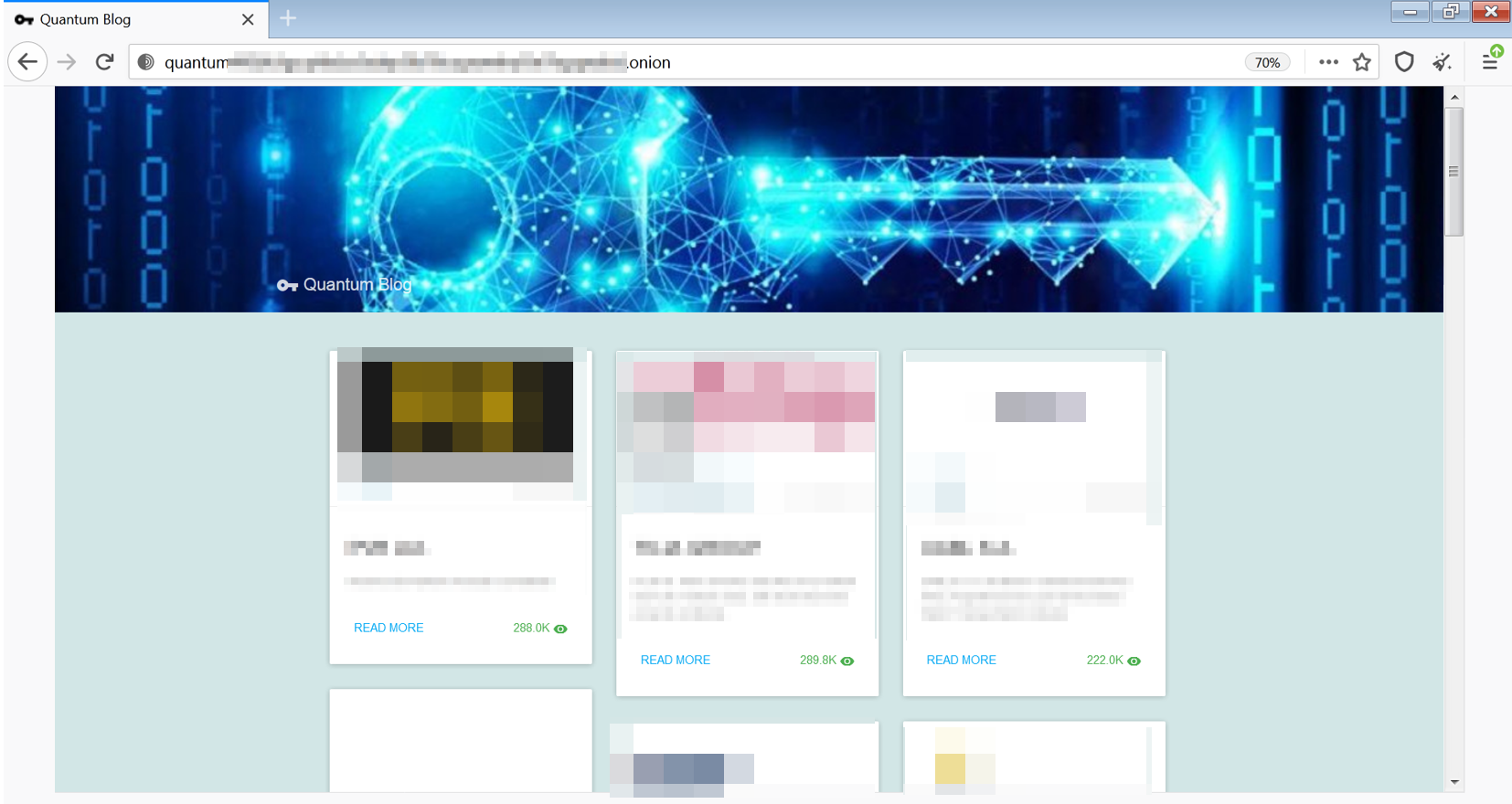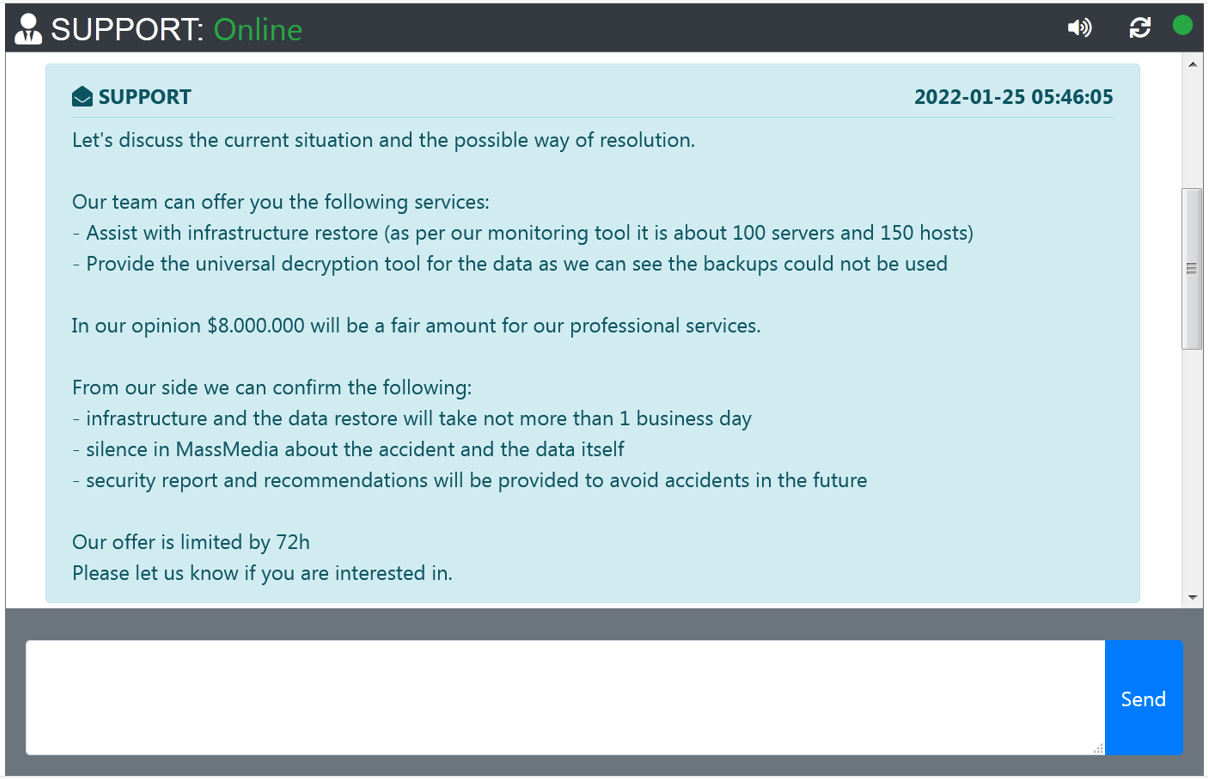The Quantum Locker is a ransomware strain that was first discovered in July 2021. Since then, the ransomware was observed used in fast ransomware attacks, in some cases even Time-to-Ransom (TTR) of less than 4 hours, leaving defenders little time to react.
Key Details
- Time-to-Ransom (TTR) of less than 4 hours: From initial infection to encryption takes even less than 4 hours, leaving a very short window for defenders to successfully defend against the threat.
- High Severity: The Cybereason Nocturnus Team assesses the threat level as HIGH given the destructive potential of the attacks.
- Human Operated Attack: Prior to the deployment of the ransomware, the attackers attempt to infiltrate and move laterally throughout the organization, carrying out a fully-developed RansomOps attack.
- Detected and Prevented: The AI-Driven Cybereason XDR Platform fully detects and prevents the Quantum Locker.
Cybereason Blocks Quantum Locker
The Quantum ransomware is another rebranding of the notorious MountLocker ransomware, which launched back in September 2020. Since then, the ransomware gang has rebranded its operation to various names, including AstroLocker, XingLocker, and now in its current phase, the Quantum Locker:

Same with other ransomware that follow the double extortion trend, that became already a second nature to ransomware, the Quantum Locker has its own data leak TOR website - “Quantum Blog”, and according to it the gang has over 20 victims, with 7 of them being new as of April 2022:

The ransom demands for the gang vary depending on the victim, with some attacks demanding $150,000 to receive a decryptor, while others are multi-million dollar demands, as shown below:

The victim only gets 72 hours to get back in touch with the gang, and if not - the stolen data is shared on the website for free downloads for the public:
Breaking Down the Attack
Initial Infection Vector - IcedID
The infamous malware, IcedID, that started as a banking trojan back in 2017, is observed being utilized as the initial access by various ransomware gangs. Among those gangs are Conti, REvil, and the former brand of Quantum - the Xing Locker. As for now, the gang seems to continue with this method with the Quantum Locker as well; “If it ain't broke don’t fix it.”
The campaign of IcedID observed ending in Quantum Locker execution starts with a phishing attack via email. The email contained an .iso image file that contains the IcedID loader payload in the form of a DLL (dar.dll) and shortcut file - an .LNK file - that targets the IcedID payload and masquerades as a document.
When mounting the .iso file, the end user only sees the shortcut file named “document”, and the DLL itself is hidden. After the user clicks on the shortcut, the IcedID DLL is executed:
The unpacked DLL is loaded into memory (loader_dll_64.dll) and it begins its communication with the C2:
As with most commodity malware, for example TrickBot, IcedID executes initial discovery commands and then exfiltrates the results via the C2 channel. If threat actors find the organization to be of interest, they will launch the next phase:
|
Cmd.exe /c chcp >&2 Ipconfig /all Systeminfo Net config workstation Nltest /domain_trusts /all_trusts Net view /all /domain Net view /all Net group Domain Admins /domain |
IcedID reconnaissance commands
Moving to an Interactive Attack
The next phase of the attack starts after IcedID sends the reconnaissance output back to the C2. In some cases, it started just two hours after the user clicks on the .lnk file. In this phase, the threat actor starts an interactive attack in the breached network. To do so, they use the initial IcedID implant to download and execute another implant. In most cases the gang used Cobalt Strike beacon to launch the interactive phase.
First, the threat actor wants to perform additional and more in-depth reconnaissance activity. They execute a script named adfind.bat that uses the tool AdFind to collect information about the Active Directory. In addition, they also run a batch script named ns.bat which runs nslookup for each host in the domain.
The AdFind.bat script is dropped in the %temp% directory, along with the AdFind.exe binary and 7Zip binary named 7.exe. The output is saved into .txt files and sent to the C2. After that, the batch file removes tracks by deleting the script, the AdFind binary, the .txt files and the 7Zip binary:
Lateral Movement
To move laterally in the environment, the threat actor first dumps the lsass process and gains credentials.
Then, they start making RDP connections to other servers in the environment and remote WMI discovery tasks to test the gained credentials:
After confirming that the credentials work, the threat actor continues to prepare for the deployment of the Quantum Locker. They start spreading in the network by copying the ransomware binary to the other machine's c$\windows\temp\ shared folder and then execute them remotely via WMI and PsExec.
Ransomware Execution
Upon execution, the ransomware first checks for the presence of different services and processes related to security software such as AVs, malware analysis tools, Microsoft Office, browsers and databases. If found, the ransomware tries to kill the service / process:
|
msftesql.exe sqlbrowser.exe sqlwriter.exe oracle.exe ocssd.exe dbsnmp.exe synctime.exe agntsvc.exe isqlplussvc.exe xfssvccon.exe sqlservr.exe encsvc.exe ocautoupds.exe mydesktopservice.exe firefoxconfig.exe firefoxconfig.exe |
ocomm.exe mysqld.exe sqlagent.exe mysqld-nt.exe mysqld-opt.exe dbeng50.exe sqbcoreservice.exe excel.exe infopath.exe msaccess.exe mspub.exe onenote.exe outlook.exe powerpnt.exe sqlservr.exe visio.exe winword.exe |
wordpad.exe QBW32.exe QBW64.exe ipython.exe wpython.exe python.exe dumpcap.exe procmon.exe procmon64.exe procexp.exe procexp64.exe steam.exe thebat64.exe thunderbird.exe |
List of processes to terminate
Then, the ransomware starts its encryption routine. It encrypts the files on the disc and appends the .quantum extension to it. It also leaves a ransom note named README_TO_DECRYPT.html:
In addition, the ransomware creates a log file for its execution named <ransom_binary>.exe.log. This log file contains information about the machine, user, domain, killed processes and services, and each file's status - if it was encrypted or skipped.
Cybereason Detection and Prevention
The AI-driven Cybereason XDR Platform is able to prevent the execution of the Quantum Locker using multi-layer protection that detects and blocks malware with threat intelligence, machine learning, and next-gen antivirus (NGAV) capabilities. Additionally, when the Anti-Ransomware feature is enabled, behavioral detection techniques in the platform are able to detect and prevent any attempt to encrypt files and generates a MalOpTM for it:
Using the Anti-Malware feature with the right configurations (listed in the recommendations below), the Cybereason XDR Platform will also detect and prevent the execution of the ransomware and ensure that it cannot encrypt targeted files. The prevention is based on machine learning, which blocks both known and unknown malware variants:
Security Recommendations
- Enable the Anti-Ransomware Feature on Cybereason NGAV: Set Cybereason Anti-Ransomware protection mode to Prevent - more information for Cybereason customers can be found here
- Enable Anti-Malware Feature on Cybereason NGAV: Set Cybereason Anti-Malware mode to Prevent and set the detection mode to Moderate and above - more information for cybereason customers can be found here
- Keep Systems Fully Patched: Make sure your systems are patched in order to mitigate vulnerabilities
- Regularly Backup Files to a Remote Server: Restoring your files from a backup is the fastest way to regain access to your data
- Use Security Solutions: Protect your environment using organizational firewalls, proxies, web filtering, and mail filtering
Indicators of Compromise
|
IOC |
Type |
Description |
|
b63e94928da25e18caa1506305b9ca3dedc267e747dfa4710860e757d2cc8192 1d64879bf7b1c7aea1d3c2c0171b31a329d026dc4e2f1c876d7ec7cae17bbc58 511c1021fad76670d6d407139e5fef62b34ca9656fb735bd7d406728568fa280 faf49653a0f057ed09a75c4dfc01e4d8e6fef203d0102a5947a73db80be0db1d 0f3bb820adf6d3bba54988ef40d8188ae48b34b757277e86728bdb8441d01ea2 0789a9c0a0d4f3422cb4e9b8e64f1ba92f7b88e2edfd14b7b9a7f5eee5135a4f |
SHA256 |
Quantum binaries |
|
8d30ab8260760e12a8990866eced1567ced257e0cb2fc9f7d2ea927806435208 2c84b5162ef66c154c66fed1d14f348e5e0054dff486a63f0473165fdbee9b2e 116e8c1d09627c0330987c36201100da2b93bf27560478be4043c1a834ad8913 99a732c0512bc415668cc3a699128618f02bf154ff8641821c3207b999952533 f72c47948a2cb2cd445135bc65c6bf5c0aaacc262ee9c04d1483781355cda976 f8136eb39ee8638f9eb1acf49b1e10ce73e96583a885e4376d897ab255b39bd6 79e25568a8aeec71d18adc07cdb87602bc2c6048e04daff1eb67e45f94887efc d44c065f04fe13bd51ba5469baa9077efb541d849ad298043739e08b7a90008f 239d1c7cfd5b244b10c56abbf966f226e6a0cb91800e9c683ba427641e642f10 7522b6de340a68881d11aa05e2c6770152e2d49ca5b830821ffce533fad948fd 5bc00ad792d4ddac7d8568f98a717caff9d5ef389ed355a15b892cc10ab2887b |
SHA256 |
IcedID .iso files |
|
138[.]68.42.130 157[.]245.142.66 188[.]166.154.118:80 |
IP |
IcedID C2 |
|
dilimoretast[.]com antnosience[.]com oceriesfornot[.]top arelyevennot[.]top |
Domain |
IcedID C2 |
MITRE ATT&CK TECHNIQUES
|
Initial Access |
Lateral Movement |
Execution |
Defense Evasion |
Credential Access |
Discovery |
Collection |
Impact |
|
|
|||||||
|
|
|||||||
|
|
About the Researcher:
As part of the Nocturnus team at Cybereason, Lior has created procedures to lead threat hunting, reverse engineering and malware analysis teams. Lior has also been a contributing researcher to multiple threat and malware blogs including Bitbucket, Valak, Ramnit, and Racoon stealer. Prior to Cybereason, Lior led SOC operations within the Israeli Air Force.
